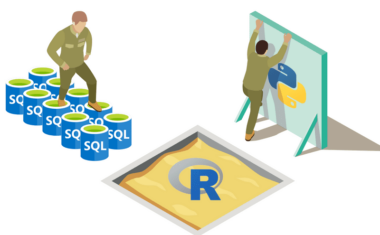How Do You Become a Machine Learning Engineer?

In this article
Whenever you’re browsing film and television recommendations on Netflix, encountering ads on social media that are relevant to your interests or search history, or voicing commands to Amazon’s Alexa or Apple’s Siri, you’re directly interacting with the work of a machine learning engineer.
While it takes a lot of dedication to gain both the data science and computer science fundamentals needed to become a machine learning engineer, there is a rewarding payoff: machine learning engineers are part of a rapidly evolving field that works at the forefront of deep learning and artificial intelligence and have a growing impact on the efficiency and innovation of industries ranging from entertainment to retail, healthcare, finance, tech, and auto.
Machine learning is a rapidly growing field that is integral to the development of artificial intelligence. Learn more about how to become a machine learning engineer here.
What is a machine learning engineer?
A machine learning engineer is a computer programmer who designs and builds self-running software that learns from data and automates predictive models. Because of the interdisciplinary nature of the job—needing both an understanding of data models and data structures and the ability to deploy those models in usable software—machine learning engineers sit at the intersection of software engineering and data science, possessing skills from both disciplines.
For this reason, machine learning engineers are in high demand across all industries that are heavy on automation, rely on big data, or are searching for ways to make their systems and services more efficient.
What does a machine learning engineer do?
Machine learning engineers teach software and systems to learn on their own without human intervention. Think about YouTube and Netflix’s recommendation engines; Amazon’s purchasing suggestions; social media apps and platforms being able to detect spam or inappropriate content on their own.
In action, this involves performing dozens of different tasks, such as running machine learning experiments using programming languages and machine learning libraries; deploying machine learning solutions into production; optimizing those solutions for performance and scalability; implementing custom machine learning code; performing foundational data science work such as analyzing data and coming up with use cases; and performing foundational data engineering work by ensuring a good flow between databases and backend systems.
A large part of the job also requires collaboration with other stakeholders such as data scientists and researchers, software engineers, and product managers to define project goals, roadmaps, and how each professional’s work can inform the work of others.
Machine learning engineer job description, skills, & more
While job descriptions for machine learning engineers will vary depending on industry, organization, and team, a typical machine learning engineering job description will emphasize the need for someone who can design and train computers to learn automatically.
Underscoring this skill set is a background in both data science and software engineering.
On the data science front, expected skills include proficiency with programming languages such as Python, SQL, and Java; the ability to perform hypothesis testing; data modeling; proficiency in mathematics, probability, and statistics (such as the Naive Bayes classifiers, conditional probability, likelihood, Bayes rule and Bayes nets, Hidden Markov Models, etc.), an understanding of variance, correlations, and dynamic programming, and being able to develop an evaluation strategy for predictive models and machine learning algorithms.
On the software engineering front, expected skills include proficiency with system design; understanding data structures such as stacks, queues, graphs, trees, and multi-dimensional arrays; understanding computability, complexity, and approximate algorithms; and knowledge of computer architecture such as memory, clusters, bandwidth, deadlocks, and cache.
Learn more about a machine learning engineer job description, skills, and more here.

How to become a machine learning engineer in 6 steps
Machine learning engineering is a relatively new and constantly evolving field. Because of this, there is no ‘right’ way to become a machine learning engineer. There are multiple ways to get into the field depending on your educational background, technical skills, and areas of interest.
The steps below outline how you can get hired as a machine learning engineer.
- Understand your end goal. Before you decide to pursue a bachelor’s or master’s degree or enroll in an online bootcamp, it’s important to be clear about what you want out of a career in machine learning engineering so that you can determine the best path to take. Some careers in machine learning will require a bachelor’s degree in computer science, mathematics, statistics, or a related field, while others will require you to go further and obtain a master’s degree or Ph.D. Others yet will determine eligibility based on work experience and the transferability of your skills. Either way, preparing for a career in machine learning engineering takes hard work and commitment, so it’s important to understand your end goal.
- Learn software engineering fundamentals. Machine learning engineers write the code that powers systems and programs, so they need to be deeply familiar with both an array of programming languages (Python, Java, and C++ are the most popular) and foundational computer science so that they can build and deploy software.
- Learn data science fundamentals. One of the key things that set machine learning engineers apart from traditional software engineers is their overlap with data scientists. In addition to developing a solid software engineering skillset, anyone interested in machine learning engineering should know how to find, clean, optimize, and query data sets; understand data models; and bridge the findings from data science with the building blocks of software engineering.
- Familiarize yourself with the tools and concepts. In addition to learning programming languages, it helps to familiarize yourself with commonly used machine learning infrastructure and concepts. For example, machine learning engineers working with AI and deep learning will likely use tools such as TensorFlow, Spark and Hadoop, R Programming, Apache Kafka, Weka, and MATLAB. ML engineers tasked with training virtual assistants or chatbots will likely need to understand natural language processing, neural networks, regression models, and informational retrieval.
- Work on real-life projects. The most important part of becoming a machine learning engineer is understanding how to apply your theoretical knowledge to actual tasks and assignments. Completing a machine learning engineering project end-to-end and documenting it in a portfolio will show future employers your ability to understand and deliver at every step of a project.
- Do an online course or bootcamp. While some machine learning engineers find success in completing these steps on their own, many benefit from additional support. For this reason, candidates often turn to an online bootcamp for a comprehensive and supported approach to learning ML engineering.
Get To Know Other Data Science Students
Jasmine Kyung
Senior Operations Engineer at Raytheon Technologies
Abby Morgan
Data Scientist at NPD Group
Mikiko Bazeley
ML Engineer at MailChimp
How can Springboard help you become an ML engineer?
Want to know how to get into machine learning engineering or a related field? Springboard’s Machine Learning Engineering Career track is comprehensive, production-focused, and designed for people with strong software engineering or computer programming skills who want to become machine learning engineers.
The online, six-month curriculum will help you master key aspects of machine learning engineering such as machine learning models, deep learning, computer vision image processing, the machine learning engineering stack, and working with data. Most importantly, 50% of the course is focused on production engineering skills, which ensures that you not only graduate with a solid understanding of machine learning and deep learning concepts, but you also get the hands-on experience that hiring managers value.
In addition, you will learn to:
- Design a machine learning/deep learning system, build a prototype, and deploy a running application that can be accessed via API or a web service
- Understand and work with common deep neural network configurations, linear algebra and calculus, and engineering frameworks such as Keras, TensorFlow, PyTorch, Fast.ai, and CuPy
- Work with object detection and image segmentation techniques
- Create reliable and reproducible data pipelines to ensure your model is well fueled
- Use data science, machine learning, and software engineering tools
- Perform classification modeling, regression modeling, optimization, and build recommendation systems
As with all of Springboard’s courses, you will also receive unlimited one-on-one support from an industry mentor, get experience working on real-world projects, and have access to career support and a job guarantee in a machine learning engineer role after completing the course.

Machine learning engineer FAQs
Want to know more about how to get into machine learning engineering? Read on to find the answers to some frequently asked questions.
What should a machine learning engineer know?
The first requirement is to have a strong grasp of computer science and data science skills, which means learning programming languages such as C++, Python, R, SQL, and Java, and tools such as MapReduce, TensorFlow, and Spark.
You should also be familiar with both the concepts and application of statistics, mathematics, neural network architecture, signal processing techniques, data structures, memory management, and AI training.
Are machine learning engineers in demand?
Machine learning engineering offers strong career stability and varied opportunities because it is in such high demand across multiple industries—the profession saw a 344% increase in job listings from 2015-2018, and this number is expected to rise in the coming years as more organizations realize the potential of marrying big data with software.
Can you learn machine learning without coding?
If you want to get into machine learning engineering, you’ll have to learn how to code. There’s no way around it—many machine learning tasks require at least a familiarity with programming languages such as Python, Javascript, R, or C++.
While it is possible to learn and understand some machine learning concepts without dabbling in code, a machine learning engineer who wants to implement machine learning models that tackle real-world problems will have to have a strong coding background. In fact, even having basic programming knowledge will open doors in machine learning because it will make accessible graphical and scripting ML environments such as Weka, Orange, and BigML, as well as machine learning libraries, which will allow you to perform complex tasks without having to write too much code.
Is machine learning engineering a good career?
Machine learning engineering is a high-paying, in-demand profession that is seeing rapid job growth and generous salaries.
Indeed ranked the profession number one in 2019 based on the number of open roles and the average compensation—344% growth in job postings from 2015-2018; an average base salary of around $146,085—describing it as an “extremely promising position.”
In addition to job security, machine learning engineering offers enormous variety and industry flexibility because machine learning engineers are needed across many different sectors, from government and healthcare to entertainment and tech, to finance and retail.
Can you become a machine learning engineer without a degree?
Most machine learning engineering positions require at least a bachelor’s degree or master’s degree in computer science, mathematics, statistics, or a related field. But the key determining factor in whether a person lands a machine learning engineering role is whether they have the knowledge, experience, and portfolio of projects to prove that they can get the job done. For this reason, it is not unheard of for a candidate without a degree to get hired if they can show that they have relevant experience.
It’s also not uncommon for candidates who hold degrees in unrelated fields to retrain—either through short courses, online bootcamps, or self-study—to pick up the relevant skills and experience and begin their careers in machine learning engineering.
How long does it take to become a machine learning engineer?
It takes approximately six months to complete a machine learning engineering curriculum. If an individual is starting without any prior knowledge of computer programming, data science, or statistics, it can take longer.
Springboard’s Machine Learning Engineering Career Track takes 6 months to complete. Springboard’s Data Science Prep Course, which teaches foundational programming and statistics, takes 4-6 weeks to complete.
Is it hard to become a machine learning engineer?
Becoming a machine learning engineer requires commitment. The role is multidisciplinary, requiring the technical development skills of a software engineer and the analytical skills of a data scientist.
Those who have a background in computer science, artificial intelligence, software development, statistics, data science, or data engineering will have a head start, but it is not uncommon for individuals to begin from scratch and be working in machine learning within a few years. After all, machine learning and artificial intelligence are relatively new and frequently evolving fields, which means there’s always more to learn—and plenty of room for newcomers.
Since you’re here…Are you a future data scientist? Investigate with our free guide to what a data scientist actually does. When you’re ready to build a CV that will make hiring managers melt, join our Data Science Bootcamp that guarantees a job or your tuition back!





